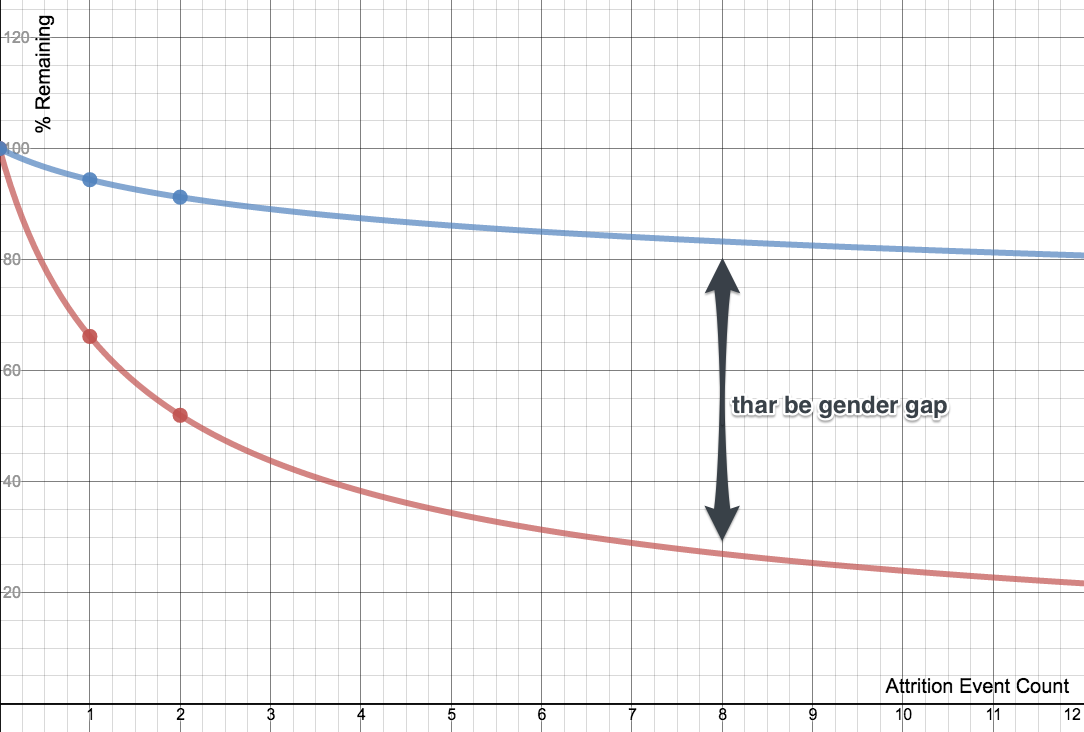Masking the floor at the interview via voice modulator
 Many copies are broken because of gender inequality in IT: there are more male programmers than women. This fact is confirmed by stereotypical perceptions, and numerous studies, and Habr statistics .
Many copies are broken because of gender inequality in IT: there are more male programmers than women. This fact is confirmed by stereotypical perceptions, and numerous studies, and Habr statistics .The salary of female programmers is, on average, less than the male one. Why it happens? The standard answer is due to gender discrimination. They say that programming is considered a "non-female" profession, therefore, at the interview stage, women are biased. It is believed that in the workplace they are also treated differently: the requirements are lower, the salary is lower.
The company Interviewing.io conducted an interesting experiment with disguising the floor during an interview - and checked how this affects the results.
')
Left picture: Lead programmer Margaret Hamilton next to a stack of printouts of the Apollo spacecraft control computer code
According to Glassdoor statistics , the difference in wages between men and women exists in all professions, but it is the worst in IT. The difference between the salaries of men and women averages 28.3%.
Inside IT, the largest wage gap is observed in the development of scientific software and programming for mainframes. Someone may say that in the latter case, the presence of a beard raises the salary - and there really is such a correlation!
There is a very large gender difference in other IT areas, which are traditionally considered “boy clubs”. In the development of computer games, women are paid 15.8% less, in information security - by 14.7%.
So what is the reason?

Margaret Hamilton (Margaret Hamilton), leading programmer of the Apollo spacecraft onboard computer control
Interviewing.io Experience
Users of the Interviewing.io project anonymously practice in passing technical interviews - something like a chatroulette for programmers. The site even promises to find a job based on the results of virtual interviews. While free access is closed, registration is in the order of turn.
The interview takes place on the site. The applicant and the employer meet in a joint working environment for programming, with voice and text chat and the like of a whiteboard. The performing role of the employer sees on the screen everything that the virtual applicant types in the editor. The two sides communicate. After each interview, the employer assesses several parameters:
- Would you take this candidate for a job? Well no
- Technical grade assessment: from 1 to 4
- Assessment of ability to solve problems: from 1 to 4
- Communication Abilities: 1 to 4
- Separate graph to send comments to the applicant
The service is only a few months old, but over a thousand interviews have already been conducted. You can notice the expected patterns. Women show at interviews the result is worse than men. Men enter the next round of interviews 40% more often. In technical evaluation, their average result is 3 points versus 2.5 points for women.
Experiment
Perhaps the fact is that interviewers prefer men, and women programmers are not taken seriously? To test this assumption, a voice modulator was used at Interviewing.io to “change the gender” of the candidate during the interview.
Voice modulator sounds like this.
Interview without voice modulation
Voice Modulation Interview
In total, 234 candidates took part in the experiment, of which about one third were women and two thirds were men. In order to observe the maximum purity of the experiment, all participants were warned that during the interview their voice could be changed, and they were asked not to give out their real gender. Each participant was defined in one of three categories:
- The voice did not change (control group)
- Modulation without changing height
- Height modulation (“floor change”)
The second group is necessary for the purity of the experiment, because the operation of the modulator is not as ideal as we would like. In the voice chat, you can hear if the person has a real or "synthetic" voice. If there were no second group, then the employer notified of the experiment could understand that every synthetic male voice is actually a woman, and vice versa. And if you modulate the voices of the male / female frequency with a probability of 50 to 50, then the mere fact of modulation no longer says anything.
How did the results of the interview change after disguising the floor?
The result was the opposite of what the experimenters expected. It turned out that disguising the floor does not affect the results of the interview . Even after disguising the voice, women continued to show worse results, and it was still easier for men to go to the next stage of the interview.
On the contrary, a reverse trend appeared. Men with a modulated voice women were marginally better than men without modulation. Women with men's voices were slightly worse than women without modulation.
Researchers cannot explain this strange phenomenon. They only indicated that women more often than men tend to give up, refusing repeated interviews after failure. But this statistic still does not fully explain why women, even with a male voice, are rated worse for technical abilities. And it’s even more unclear why men improve their performance after a change of voice to a more high-frequency female.
It can be assumed that people recognize gender by voice so well that no modulator is able to create a 100% disguise. Perhaps the case is in the use of certain vocabulary, in the construction of sentences, in the rate of speech and pauses. And this, by the way, explains the effect when men with a modulated voice get more advantages - the interviewer feels a trick and subconsciously overestimates (guided by all the same stereotypes) the result of the man who was made to look like a woman.

Failures are much faster wear women assertiveness than men. And how many such difficulties are to be faced throughout the programmer’s career, starting with university studies and ending with a series of unsuccessful interviews?
It seems that the difference in the results of the interview and, therefore, in the salary levels is due not to the bias of the employers, but to something else. Perhaps gender discrimination does not exist at all? There is still a lot of research to be done in this area.
More women in IT
Despite the controversial results of various studies, the largest IT companies in the world set themselves the goal of hiring more minority programmers, including women. The ideal situation is when women in the company exactly the same as men. This goal is based on the assumption that if bias is eliminated during an interview, the percentage of men and women should be about 50 to 50. Without questioning this thesis, some companies diligently increase the female presence - and periodically report on their successes.
In May 2014, Google became one of the first companies in Silicon Valley, which dared to publish honest figures on gender equality. According to Google statistics, women accounted for 30% of the state. This result is above average - in all computer specialties in the United States, this figure is only 18% .
As of January 2015, the percentage of wives in the state of Google has not changed , but the company reported on other successes. For example, among the visitors of the conference for Google I / O developers, the number of women in 2013 was 8%, in 2014 - 20% and in 2015 - 23%.
In the project, the Asana project management application generally changed the standard interview procedure. Now during the tests on the whiteboard, when the candidate girl writes the code, Asana interviewers leave the room so as not to embarrass her.
Source: https://habr.com/ru/post/304434/
All Articles